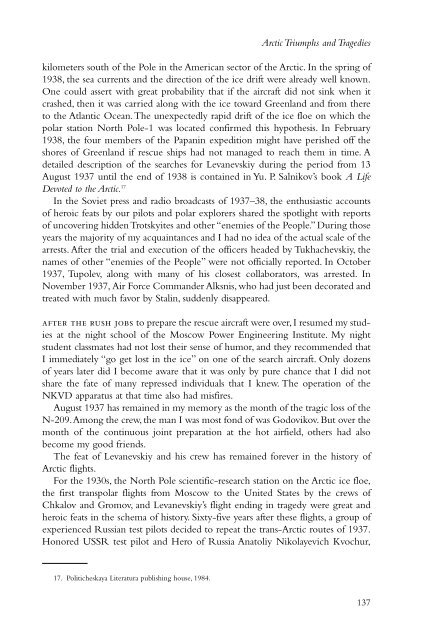to open next chapter. - NASA's History Office
to open next chapter. - NASA's History Office
to open next chapter. - NASA's History Office
You also want an ePaper? Increase the reach of your titles
YUMPU automatically turns print PDFs into web optimized ePapers that Google loves.
Arctic Triumphs and Tragedies<br />
kilometers south of the Pole in the American sec<strong>to</strong>r of the Arctic. In the spring of<br />
1938, the sea currents and the direction of the ice drift were already well known.<br />
One could assert with great probability that if the aircraft did not sink when it<br />
crashed, then it was carried along with the ice <strong>to</strong>ward Greenland and from there<br />
<strong>to</strong> the Atlantic Ocean.The unexpectedly rapid drift of the ice floe on which the<br />
polar station North Pole-1 was located confirmed this hypothesis. In February<br />
1938, the four members of the Papanin expedition might have perished off the<br />
shores of Greenland if rescue ships had not managed <strong>to</strong> reach them in time. A<br />
detailed description of the searches for Levanevskiy during the period from 13<br />
August 1937 until the end of 1938 is contained in Yu. P. Salnikov’s book A Life<br />
Devoted <strong>to</strong> the Arctic. 17<br />
In the Soviet press and radio broadcasts of 1937–38, the enthusiastic accounts<br />
of heroic feats by our pilots and polar explorers shared the spotlight with reports<br />
of uncovering hidden Trotskyites and other “enemies of the People.” During those<br />
years the majority of my acquaintances and I had no idea of the actual scale of the<br />
arrests. After the trial and execution of the officers headed by Tukhachevskiy, the<br />
names of other “enemies of the People” were not officially reported. In Oc<strong>to</strong>ber<br />
1937, Tupolev, along with many of his closest collabora<strong>to</strong>rs, was arrested. In<br />
November 1937, Air Force Commander Alksnis, who had just been decorated and<br />
treated with much favor by Stalin, suddenly disappeared.<br />
after the rush jobs <strong>to</strong> prepare the rescue aircraft were over, I resumed my studies<br />
at the night school of the Moscow Power Engineering Institute. My night<br />
student classmates had not lost their sense of humor, and they recommended that<br />
I immediately “go get lost in the ice” on one of the search aircraft. Only dozens<br />
of years later did I become aware that it was only by pure chance that I did not<br />
share the fate of many repressed individuals that I knew. The operation of the<br />
NKVD apparatus at that time also had misfires.<br />
August 1937 has remained in my memory as the month of the tragic loss of the<br />
N-209.Among the crew, the man I was most fond of was Godovikov. But over the<br />
month of the continuous joint preparation at the hot airfield, others had also<br />
become my good friends.<br />
The feat of Levanevskiy and his crew has remained forever in the his<strong>to</strong>ry of<br />
Arctic flights.<br />
For the 1930s, the North Pole scientific-research station on the Arctic ice floe,<br />
the first transpolar flights from Moscow <strong>to</strong> the United States by the crews of<br />
Chkalov and Gromov, and Levanevskiy’s flight ending in tragedy were great and<br />
heroic feats in the schema of his<strong>to</strong>ry. Sixty-five years after these flights, a group of<br />
experienced Russian test pilots decided <strong>to</strong> repeat the trans-Arctic routes of 1937.<br />
Honored USSR test pilot and Hero of Russia Ana<strong>to</strong>liy Nikolayevich Kvochur,<br />
17. Politicheskaya Literatura publishing house, 1984.<br />
137
















